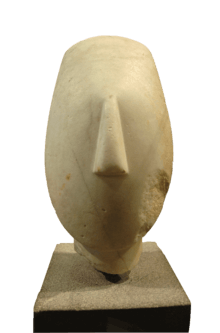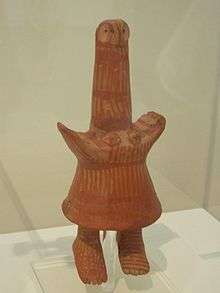Aegean art

Aegean art refers to art that was created in the Grecian lands surrounding, and the islands within, the Aegean Sea before the start of Ancient Greek art, which is normally dated around the 11th century BC. Included in the category Aegean art is Mycenaean art, famous for its gold masks, war faring imagery and sturdy architecture consisting of citadels on hills with walls up to 20 feet thick and tunnels into the bedrock, the art of the Cyclades, famous for its simple "Venus" figurines carved in white marble, and Minoan art which is famous for its animal imagery, images of harvest, and light, breezy, non-warlike architecture which is almost the antithesis of the Mycenaean art. Taking all this into account, the term "Aegean Art" is thought of as contrived among many art historians because it includes the widely varying art of very different cultures that happened to be in the same area around the same period.
In the Bronze Age, about 2800–1100 BC, despite cultural interchange by way of trade with the contemporaneous civilizations of Egypt and Mesopotamia, the Aegean cultures developed their own highly distinctive styles.
The elegant art of the Aegean figurines has recently been used at the 2004 Summer Olympics,held at Athens; specifically, during the opening ceremony and as the original idea behind the games mascots: Athina and Fivos.

This type of figurines are furthermore particularly intriguing, because of the high resemblance they have with modern sculptures (e.g. Henry Moore's works).
Mycenaean art
Mycenaean art is most prominently dated between 1600 and 1100 BC during the Late Helladic period of Greece. The Mycenean art is named after the inhabitants of Mycenae descending from early Greek tribes of 2000 BC and approximately 3000 to 1100 BC.
Architecture
Mycenaean palaces were generally placed on hilltops surrounded by defensive walls constructed of large stone blocks. The Lion Gate is one of the few remaining structures of Mycenaean architecture inspiring later Greek cultures. Gates such as the latter functioned as guardians of the gate. At the center of the palaces were royal audience halls called the Megaron defined by a round hearth in the center and four columns supporting its roof. Structures always featured roofs of fired tiles.
Sculpture
Sculpture of the Mycenaean era was most commonly found in royal palaces. Shrines for gods were the most common sculpture type. Figures were richly curved portraying a sense of flexibility in movement.
Cycladic art
Cycladic art originates between 2600 and 1100 BC. Those that inhabited the Cycladic Islands during this time period left very little trace of their existence apart from their stone tombs. Cycladic art includes a large number of marble idols, almost all representing an upright standing nude figure, most commonly female and with arms folded across chest. The female figure is thought to represent the mother and fertility goddess. Cycladic nude figurines are fairly primitive yet distinctive to the area. They are defined by very flat, wedge shaped bodies, columnar necks and oval featureless faces apart from well defined noses. Figures have very subtle curves and subtle markings of knees and abdomen.
Minoan art
Minoan civilization is defined by a lack of continuity, growth and development cannot be thought of as the civilization disappears and reappears very abruptly of which not much is known about. Minoan art is very playful, and displays rhythm and motion.
Architecture
Minoan civilization is known for constructing several large and great palaces, most commonly Knossos, Phaistos, and Malia which were destroyed around 1700 BC and rebuilt and then suffered some destruction again around 1500 BC. The "new" palaces are the main source of information on Minoan architecture. The palace of Knossos called the Palace of Minos is the most elaborate and ambitious of the three. It is characterized by a vast number of rooms over a large amount of land. It has currently been excavated and partially restored. Minoan architecture is defined by its numerous porticoes, staircases, storerooms, workshops, and air shafts that would have provided the structure with an open feeling. Interior rooms are typically small with low ceilings, but have richly decorated walls. Although none have survived, by depiction in painting and sculpture it is known that columns in the Minoan palaces were constructed of wood. Minoan architecture are thought to be a place of not only royal residence but the administrative center and commercial activity.
Paintings, pottery and reliefs
Between 2000 and 1700 BC Minoan pottery is defined by its technical perfection and dynamic swirling ornament and its art is characterized by its naturalistic and rhythmic movement. Many murals and reliefs were scenes from nature depicting animals, birds, and sea creatures in lush vegetation; marine life being favored. Most images are flat in form and silhouetted against backgrounds of solid color. Forms from this era typically portray a weightlessness as they seem to float or sway. Human figures are painted as slim-waisted and athletic in body type for both male and female differentiating only in skin color; females are lighter in skin tone.
See also
External links
- Aegean Page
- Sideris A., Aegean School of Sculpture in Antiquity Cultural Portal of the Aegean Archipelago, Foundation of the Hellenic World, Athens 2007.
- Greek art of the Aegean Islands, Issued in connection with an exhibition held November 1, 1979-February 10, 1980, Metropolitan Museum of Art, New York, sponsored by the Government of the Republic of Greece, complemented by a loan from the Musée du Louvre.